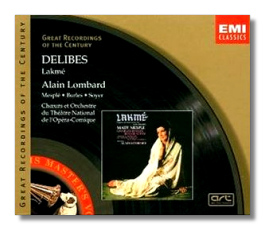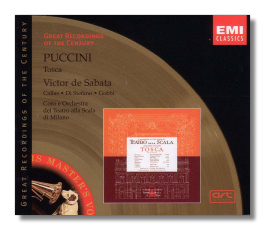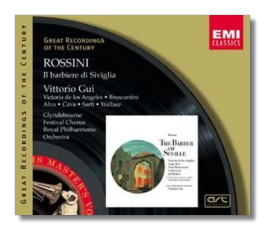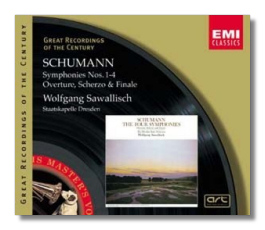
The Internet's Premier Classical Music Source
Related Links
-
Delibes Reviews
Puccini Reviews
Rossini Reviews
Schumann Reviews - Latest Reviews
- More Reviews
-
By Composer
-
Collections
DVD & Blu-ray
Books
Concert Reviews
Articles/Interviews
Software
Audio
Search Amazon
Recommended Links
Site News
 CD Review
CD Review
Great Recordings of the Century

Léo Delibes
Lakmé
- Mady Mesplé (Lakmé)
- Charles Burles (Gérald)
- Roger Soyer (Nilakantha)
- Danielle Millet (Mallika)
Orchestra & Chorus of the Théâtre National de l'Opéra-Comique/Alain Lombard
EMI Classics 67745-2 ADD 2CDs: 75:18, 74:26


Giacomo Puccini
Tosca
- Maria Callas (Tosca)
- Giuseppe di Stefano (Cavaradossi)
- Tito Gobbi (Scarpia)
- Franco Calabrese (Angelotti)
- Melchiorre Luise (Sagrestano)
- Angelo Mercuriali (Spoletta)
- Dario Caselli (Sciarrone/Un carciere)
- Alvaro Cardova (Un pastore)
Orchestra & Chorus of La Scala, Milan/Victor de Sabata
EMI Classics 67756-2 ADD Mono 2CDs: 43:12, 66:22


Gioachino Rossini
Il barbiere di Siviglia
- Victoria de los Angeles (Rosina)
- Sesto Bruscantini (Figaro)
- Luigi Alva (Almaviva)
- Carlo Cava (Don Basilio)
- Ian Wallace (Don Bartolo)
Glyndebourne Festival Chorus
Royal Philharmonic Orchestra/Vittorio Gui
EMI Classics 67762-2 ADD 2CDs: 71:27, 69:59


Robert Schumann
- Symphony #1 "Spring", Op. 38 (1841)
- Symphony #2 in C Major, Op. 61 (1841)
- Symphony #3 "Rhenish" in E Flat Major, Op. 97 (1850)
- Symphony #4 in D minor, Op. 120 (1853)
- Overture, Scherzo & Finale in E Major, Op. 52 (1841)
Staatskapelle Dresden/Wolfgang Sawallisch
EMI Classics 67771-2 ADD 2CDs: 77:16, 71:15
EMI Classics hits the hundred mark with their newest group of "Great Recordings of the Century" reissues. Opera figures heavily this time around, but classic orchestral and instrumental discs, such as Boult's The Planets and Lipatti's Schumann Piano Concerto (not reviewed here) also are worthy of attention. All reissues feature digital refurbishing courtesy of Abbey Road Studios.
I always like to make a special case for Léo Delibes's Lakmé, an opera that is so much more than the "Bell Song" (which, come to think of it, has fallen out of fashion) and the ever-present Lakmé-Mallika "Flower Duet." Lakmé is the perfect French opera-comique of its era (1882). The story – set in India – is exotic and lightly tragic. (At the end, the Indian heroine commits suicide by biting a poisonous datura flower because her British lover is deserting her.) Nevertheless, the audience goes home smiling because the tunes are so good and because the composer never allows the shade to win out over the light, Lakmé's unhappy fate notwithstanding.
EMI recorded their Lakmé in 1970, three years after Joan Sutherland and husband Richard Bonynge did their version for Decca/London. Sutherland made pretty sounds in the title role, but, by and large, the French roles eluded her. She was never idiomatic and she never made real characters out of Lakmé and Faust's Marguerite. Mesplé, in contrast, had Lakmé in her blood; she was the true successor to the stratospheric Mado Robin, the archetypal French coloratura soprano of the 1950s. Mesplé's voice may be girlish, even a little pallid, but it is an instrument that is both tremendously flexible and sweet. Her interpretation of the title role is simple but full of understanding. Burles's Gérald is gentle, virile, and gloriously sung, and as Lakmé's father, young Roger Soyer shows both authority and genuine solicitousness for her daughter's welfare. It takes a French bass to sing with such melting lightness. The smaller roles are strongly cast, and Lombard, unlike Bonynge, doesn't allow the scenes with the English visitors to become caricatures. Lombard knows what this music is all about and finds the drama in Lakmé without stifling its poetry. The sound still is excellent, thirty years later.
What is there to say about the 1953 La Scala Tosca that hasn't already been said? Recognizing its classic status, EMI has reissued it as the hundredth title in their "Great Recordings of the Century" series. (The only thing that's surprising is that none of the previous ninety-nine releases featured Maria Callas, who always has been one of the label's most popular artists.)
Most critics place this nearly fifty-year-old Tosca on the top of their lists – some as the best operatic recording ever made. Callas was in excellent voice in 1953 (beware her stereo remake from the 1960s), and the role of the spoiled, jealous, passionate, impetuous, and greatly put-upon diva suited her perfectly, both vocally and dramatically. No soprano's portrayal is fuller, and none more insightful – not just in the arias and in the big scenes, but in the tiniest details as well. Di Stefano's Cavaradossi is a study in animal magnetism, and there's hardly another role that his heroic tenor voice and assertive personality were more suited for. As Scarpia, Tito Gobbi is malice wrapped in gentility. His indignation over the goings-on in Sant' Andrea della Valle is genuine – our Chief of Police is a believer! – yet he shows no remorse over his hypocrisy and corruption. Melochiorre Luise is a vividly stuttering Sacrestan ("Ca-ca-ca-cavaradossi!") and Franco Calabrese is moving in his two brief scenes as Angelotti. De Sabata keeps the tension up without cheapening Puccini's music; his discipline and experience crown this recording. The monaural recording holds up well. Unbelievably, this is the first time that this Tosca has been made available at less than full price.
EMI recorded a series of operas at the Glyndebourne Festival, including Rossini's Le Comte Ory and Le Cenerentola. The Barbiere offered here, recorded in 1962, isn't quite an authentic Glyndebourne production, as the Rosina (Victoria de los Angeles) and the Almaviva (Luigi Alva) were imports, but the conducting of Vittorio Gui, the Figaro of Sesto Bruscantini, and the Bartolo of Ian Wallace were Glyndebourne regulars.
By any reckoning this is a desirable Barbiere. Gui was one of those conductors who believed that a slower tempo cleanly negotiated was preferable to a faster tempo that was just beyond the reach of the singers and the orchestra. As a result, what this recording lacks in kinetic excitement it gains in discipline and controlled wit. Gui meticulously observes Rossini's dynamic markings, and there's never the feeling that the conductor is relying upon routine. De los Angeles is a sweet Rosina, not a minx like Callas, but a clever girl with a knowing smile. Her coloratura, while not perfect, is impressive, but it is her personality that makes this portrayal memorable. Alva, who recorded his Almaviva with both Callas and Berganza (DG), is at his peak here: funny, flexible, and engaging. It is unusual to have a Figaro whose voice is darker than Basilio's, but such is the case here. The potential imbalance is avoided through Bruscantini's personable interpretation of Figaro, and through Wallace's dry and comical timbre. Cava is an effective Basilio, and the small roles are done with flair. All in all, though, this is an ensemble performance, with no one singer hogging the spotlight, and that approach is exactly right for this opera. The sound is a little lasklustre, but still serviceable; extraneous noises are picked up by the microphones with surprising frequency.
Sawallisch's Schumann is a formidable achievement, but one in which the praise must be shared with the producers and the engineering team, because they also contribute palpably to the success of this set. The symphonies and the Overture, Scherzo, and Finale were recorded in 1972 in Dresden's Lukaskirche. Schumann's thick, even redundant, scoring and the reverberant venue complement each other against all intuition to produce an orchestral timbre that glows as warmly as burnished brass – there's nothing clinical or harsh about the sound on these discs. Furthermore, Sawallisch revels in the ebullience of Schumann's inspiration and in the challenges presented by his sometimes ham-fisted orchestration. Even in the most hectic tuttis, Sawallisch creates transparency without sacrificing weight. And in terms his interpretations, Sawallisch imposes nothing extraneous on Schumann's works. Always a classicist, he relies upon the score, not upon excess, to illuminate the music. Tempos tend to be driving, and accents tend to be emphatic, strengthening the similarities between Schumann and Beethoven. In fact, those two composers have never spoken to each other so pointedly as they do in this set.
The story behind these recordings is curious. Sawallisch and the orchestra were to have recorded Wagner's Rienzi, but the last-minute withdrawal of two of the star singers left them "all dressed up with no place to go," so the Schumann symphonies were recorded instead. No offense to Wagner, but I am not sad that things worked out the way that they did. Sawallisch's Schumann is the genuine article.
Copyright © 2002, Raymond Tuttle



















